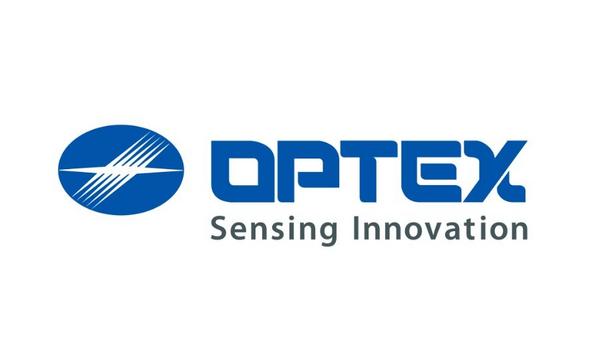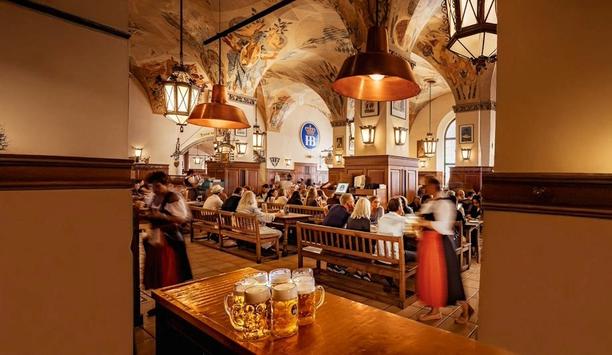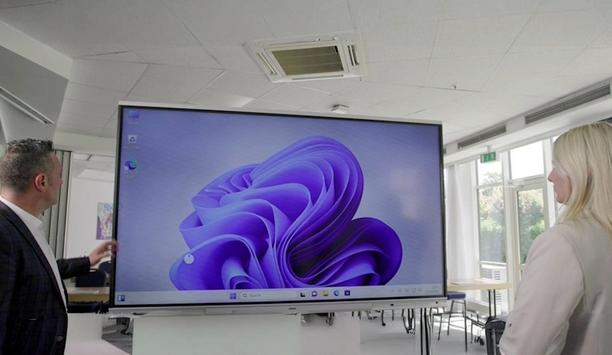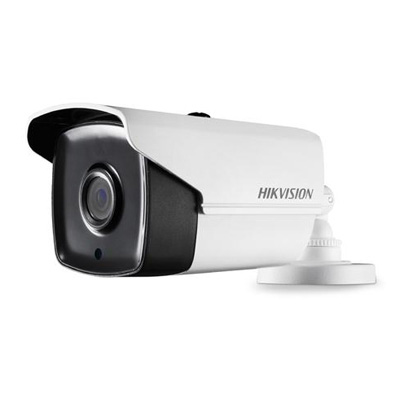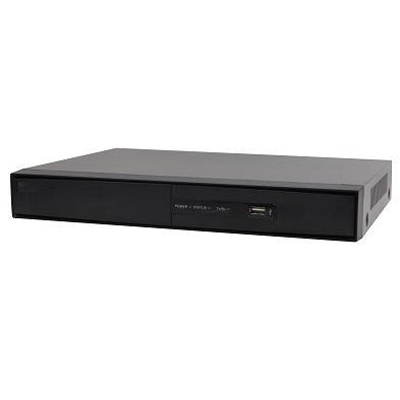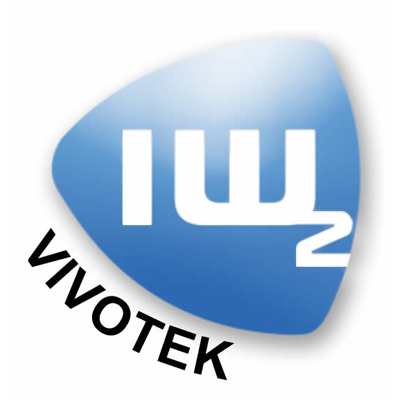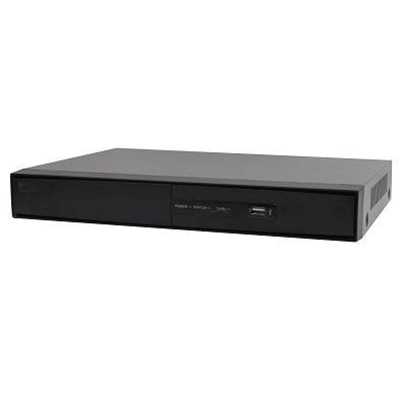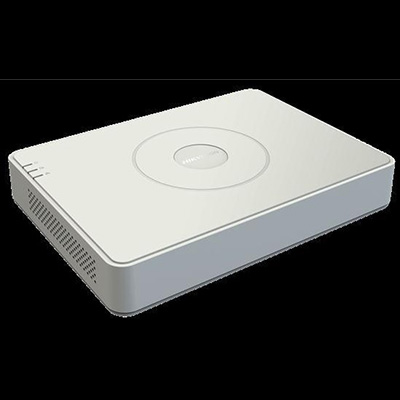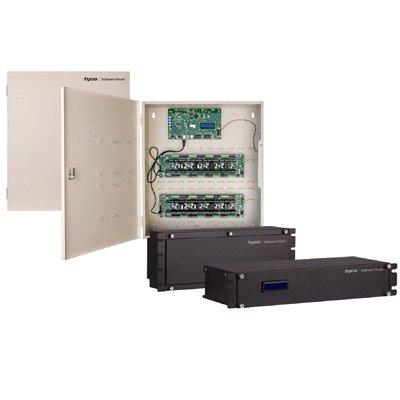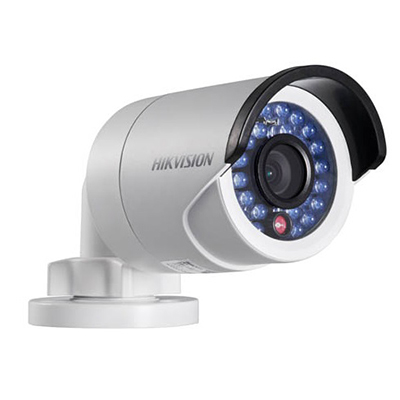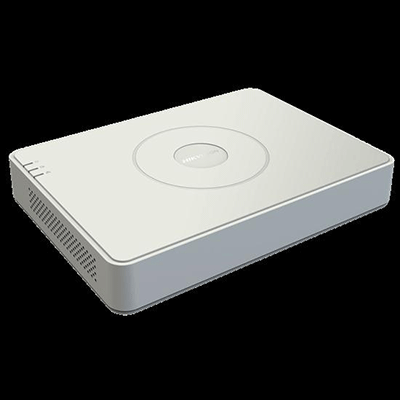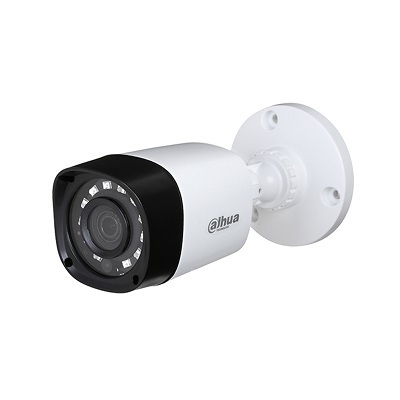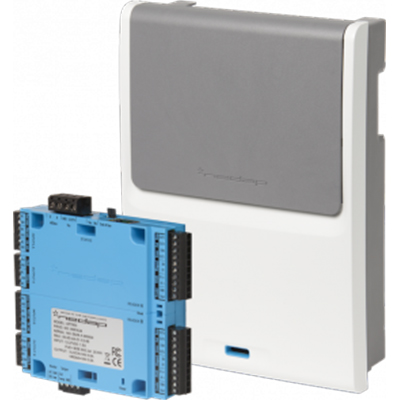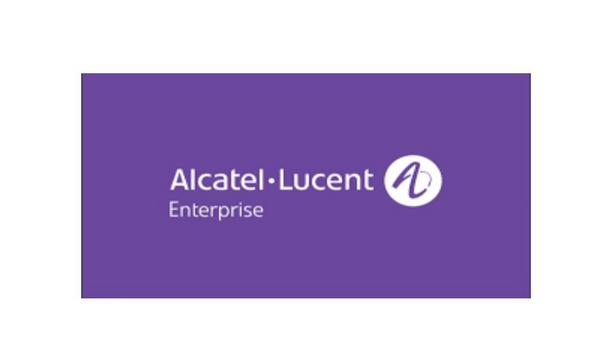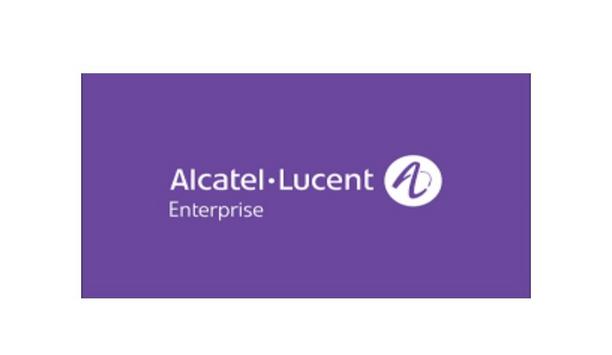Hotels, leisure & entertainment security applications
Upgrade the surveillance capabilities at MOD Pizza locations while maintaining a safe and welcoming “people-first” environment. Solution Install Hanwha Vision Q series and X series cameras (dome and fisheye models). Results Enhanced ability to deter and resolve in-store incidents involving customers and Squad members, as well as “slip and fall” accidents or crashes in the parking lot. Faster response times to police requests for surveillance footage. Hanwha secu...
OPTEX, the pioneering global sensing manufacturer, has specified and installed its compact and intelligent REDSCAN RLS-2020 LiDAR laser sensors at the new luxury five-star Londoner hotel in Leicester Square. Part of the Edwardian Hotels London group, The Londoner, which opened in September 2021, is billed as the world’s first super boutique hotel. It has 350 rooms across 16 storeys including six basement levels, featuring six concept eateries, a private members club, a cinema, a wealth o...
Munich’s Hofbräuhaus enjoys an iconic status, as both a heritage property and a spiritual home for lovers of German beer. “In this historic building is the world’s most famous tavern,” explains its Security Manager, Robert Graßl, adding “The whole world goes in and out. Security is very important.” Bavarian Duke Wilhelm V commissioned Munich’s original Hofbräuhaus in 1589, initially as a brewery to supply the Wittelsbacher Hof. Moved at...
Achat Hotel in Bochum, Germany offers comprehensive meeting and conference services, including both accommodation and catering. Due to the ever-increasing demand for interactive meeting amenities, the hotel chose and implemented the Dahua DeepHub Business Solution, providing integrated AI-powered conference and meeting capabilities for its guests. Challenge The 5 flexible and combinable meeting rooms of the Achat Hotel in Bochum can accommodate various types of events, creating a high demand...
The perimeter of a small and medium-sized business (SMB) property is its first line of defence against intruders. It keeps the premises away from theft, property loss and security incidents. Having said that, traditional methods of surveillance cannot fully catch up with the round-the-clock monitoring requirement of the scenario and unable to dispatch security personnel in time to handle abnormal situations, especially during night time. Backtracking to locate the cause of the event is deemed t...
Crystal Mountain Resort is Washington's largest winter and summer getaway. For over 60 years, the picturesque resort near Mount Rainier has drawn millions of sports enthusiasts around the world. An early adopter of new technology, the resort was also the first in Washington to install a high-speed, detachable quad chairlift, Rainier Express. Technology solution needed As the resort's Director of IT, Perry Turner is in charge of protecting over 400,000 guests and 2,600 acres of land all y...
News
Over the years, Dahua has continuously invested in the development and innovation of Full-colour technology to solve the monitoring challenges brought by low illumination. In 2018, the company launched the Starlight and Starlight+ technologies which enable cameras to effectively capture colour details in low-light environments. 24/7 colour monitoring Focusing on further improving low-light monitoring, Dahua officially released the Full-colour concept in 2020, realising 24/7 colour monitoring by introducing F1.0 super aperture, 1/1.8 '' high-performance sensor for large targets, and Dahua’s self-developed ISP 4.0 technology. The colour information of key targets in the scene can be captured even at night, which can be used as evidence in case of an investigation or backtracking. Dahua Full colour 2.0 technology Dahua TechMonth showcases some of the integrations of Full-colour technology for customers and end users In 2021, the company continued to upgrade its technology and launched the Dahua Full colour 2.0 technology. It further expanded the Full-colour “family” and integrated 4K, panoramic, zoom, and other technologies to facilitate the development of high-end products, provide a more comprehensive product system, and enhance low-light surveillance. To elaborate more about this remarkable technology, Dahua TechMonth showcases some of the integrations of Full-colour technology that create more business value for customers and end users. Recap of solutions Following is a short recap of these amazing solutions: Full-colour + TiOC The TiOC (three-in-one camera) has 3 main features: Smart Dual Illuminators, Active Deterrence, and AI. It can effectively warn off intruders with active deterrence, and notify users in time with real-time alarm, providing pro-active video surveillance to properties that require 24/7 security. TiOC utilises Full-colour technology to capture colour footage in dark scenarios. Also, its smart exposure technology realises time-sharing control and prevents the interference of flashing red & blue light in the image. To see TiOC in action, check out this video. Full-colour + Panoramic The Dahua Full-colour Dual Lens 180° Panoramic PTZ & IPC devices are equipped with dual sensors that deliver a 180-degree field of view. After the right and left lenses to capture an image, the camera calculates the feature values of the left and right images to avoid warping and pixel loss using standardised image correction technology. The Dahua advanced pixel-level metadata fusion algorithm then enables seamless splicing of the image, resulting in a seamless 180° wide-angle image. Panoramic IPC The Panoramic IPC offers EPTZ that provides a panoramic image of the scene, as well as sub-images that focus on specific areas or targets. For the panoramic PTZ camera, both panoramic and detailed views support AI functions and can be independently deployed in different directions to cover wider areas. Full-colour + ZOOM The motorised varifocal lens of the upgraded Dahua Full-colour 2.0 network cameras has approx. 5x optical zoom capability and auto-focus function, providing clear colour details of the monitored scene even after zooming in. With its long-distance illumination capability, the camera can also capture a clear full-coluor image even from far distances. Full-colour + 4K The Dahua Full-colour 4K camera delivers enhanced colour images and surveillance footage 24/7. It adopts a 1/1.2” image sensor (currently Dahua's best low-light IPC sensor) that provides a 110% pixel size increase compared to a common 8MP sensor. Its F1.0 large aperture can capture more available light and the maximum light energy that the sensor can receive is increased by 2 times. Success Case: Schwarze Berge Wildlife Park Located in Rosengarten Germany, the Schwarze Berge (Black Mountains) Wildlife Park covers an area of about 50 hectares. It is home to nearly a thousand of animals from approximately 100 species grazing in Europe. The administration of the park was looking for a comprehensive camera system that can perform many tasks. “We chose Dahua because it customised a complete solution to meet all our needs,” says Arne Vaubel, Managing Director of the Schwarze Berge (Black Mountains) Wildlife Park. Full-colour and thermal imaging In this project, a full series of innovative cameras equipped with key technologies" “In this project, a full series of innovative cameras equipped with key technologies, such as Full-colour and thermal imaging are adopted." "We are glad to see that through our cameras, the park can monitor the living environment and health status of wild animals at any moment without disturbing them, which also helps the park realise efficient operation and management,” explains Kai Wockenfuß, Pre-Sales Support Technical Engineer of Dahua Technology GmbH. Fixed-focal Warm LED Bullet WizMind Network Camera One notable Dahua camera deployed in the park is the 8MP Full-colour Fixed-focal Warm LED Bullet WizMind Network Camera. It is equipped with a high-performance sensor and large aperture lens, enabling it to capture clear colour images when it’s dark or during the night. With its photosensitivity technology, the camera can capture more available light and display more colourful footage of the monitored scene, providing 24/7 monitoring of the wildlife in the park. The future of Dahua Full-colour technology With the success of Dahua Full-colour in the market, what does the future holds for this amazing technology? For starters, minimising white light pollution is at the top of the list. Some cameras with full colour capabilities in the market still use white light, which can affect the human eye and cause severe light pollution in the monitored scene. Touchless Full-colour cameras are one solution that Dahua has been exploring through its multi-spectrum algorithm. The Dahua Multi Spectrum Fusion technology extracts the details and brightness of the visible spectrum and infrared spectrum to make the fusion brightness close to the visible light brightness, which then enables the camera to provide better images. AI integration Another aspect that Dahua is focusing on is the deeper integration of Full-colour with AI Another aspect that Dahua is focusing on is the deeper integration of Full-colour with AI. Full-colour technology is continuously being upgraded, and with that comes more intelligent solutions that can realise clear HD images at night, like it is during day time. The TiOC, for example, combines Full-colour, AI, and Active Deterrence (warning lights and siren) into one comprehensive solution, realising a closed-loop system that involves early warning, active deterrence, and backtracking. It has been recognised by many authoritative organisations in the industry and even received distinctive awards. Intelligent analysis and computing What’s more, with the constant development of this technology can enable Full-colour imaging to be directly applied to intelligent analysis and computing. It will become a mainstream technology that everyone can avail and use to optimise their scenarios, which is in line with Dahua’s mission of “Enabling a safer society, and smarter living.”
More than one million electric vehicles are registered in the U.S.—and they all have to plug in somewhere. As EV charging stations pop up across the country, one of the chief questions will be how charging station users are identified, authenticated, and connected with membership or payment systems. Radio-frequency identification cards and tokens and smartphone authentication apps have emerged as two viable options for EV charging authentication. Which is best? It may depend on the user base they plan to serve. User authentication for EV charging Most electric vehicle owners have a spot to plug in while at home, either in their own garage or carport or in a designated charging spot in a tenant parking garage. But electric vehicles also need spots to charge while owners are out and about. The EV charging market is broadly divided into two tiers: Level 2 charging stations, which operate at 208-240 V and use AC power. These stations will add 20-25 miles of range in about an hour of charging. The U.S. Department of Transportation listed more than 22,800 public Level 2 EV charging stations across the nation as of mid-2020. They are commonly found in public parking lots and garages, hotels, grocery stores, malls, and other commercial areas. They may also be installed in private parking garages and business parking lots for use by tenants, employees or fleet drivers. Collecting membership data Direct Current Fast Chargers (DCFS) are designed to charge an EV battery to about 80% in 20-30 minutes. There are currently about 15,000 DCFC stations across the U.S., but their numbers are expected to explode as more people start taking EVs on longer road trips. They are commonly found along major interstate highways. As the market evolves, user authentication requirements for EV charging stations are likely to vary by type, location, and user base. Some commercial locations may provide Level 2 EV charging as a free amenity to shoppers, guests or employees. If there is no charge for the service, there may be no need to authenticate users at all— people can simply park and plug at any available spot. However, there may be a benefit to collecting membership data (e.g., shopper reward club). Private charging stations Public, for-profit EV charging stations, like gas stations, need a method to collect payment for their services. In some cases (especially at roadside DCFS stations), users may simply pay for the minutes used with a credit card—just like at the gas station pump. However, many EV charging station users are already accustomed to identifying themselves with an RFID membership card or a smartphone app. Charging networks like ChargePoint and Blink enable members to access any EV charging station within their networks with a card or smartphone app, which connects to their membership, account, and payment information. Private charging stations—such as those offered to tenants, employees or fleet drivers—may not require payment but need to ensure that only authorised drivers are accessing power and taking up valuable parking spots. An RFID card or smartphone app can be used to identify authorised drivers and track charging behaviours. Moving forward, many EV charging stations may find that they need a mix of options for users, including membership cards, smartphone apps, and a credit card payment option for out-of-network drivers. Choosing between RFID and smartphone apps In the long run, the answer may be ‘both.’ RFID cards are economical and easy to issue When user identification and authentication are desirable, which is the better option: RFID cards or smartphone authentication? Both have their uses in the EV charging market. In the long run, the answer may be ‘both.’ RFID cards are economical and easy to issue. And for some users bases, they may not have to issue a new card at all—they can take advantage of an RFID card they already carry. In many cases, it is possible to leverage existing employee IDs and membership cards for access to privately controlled EV charging stations. RFID membership cards may be a good bet for: Fleet drivers who already carry an RFID card for vehicle access. Employee parking lots and garages where people already use a card for entry. EV charging parking spots at gyms or other locations where users want to limit charging access to active members. EV charging stations Most consumers would prefer not to have to carry a physical membership card for every retail outlet On the other hand, public charging stations may find that consumers would prefer to use a smartphone app rather than receive another membership card to carry in a physical wallet. Many consumers prefer to carry only their phone and one or two essential cards (such as a driver’s licence and a single credit or debit card). As more retailers enable consumers to pay via a digital wallet app on their smartphones, some don’t even carry a physical credit card anymore. Most consumers would prefer not to have to carry a physical membership card for every retail outlet they visit—and that includes EV charging stations. Smartphone apps for user authentication are simple to set up and highly secure. Instead of RFID, they typically use either Bluetooth® Low Energy (BLE) or Near-field Communication (NFC) protocols. Public charging stations For the user, the experience is almost identical to RFID authentication, except they wave a smartphone over the reader instead of a card. Apps have other user benefits, too. A custom app for EV charging can be configured to help users locate or reserve charging stations, check their balance and usage history, and change their payment options right on their phone. These features make smartphone authentication ideal for consumers These features make smartphone authentication ideal for consumers accessing a network of public charging stations. However, EV charging network managers should keep in mind that some users may still want a physical membership card. Smartphone-based authentication There are still some user populations, such as older consumers and those from lower income brackets, where smartphone ownership is not ubiquitous. If users are primarily using EV charging for a fleet vehicle, they may not want to download an application for work on their personal cell phone. Other users may find smartphone apps confusing or simply prefer to have a card for other reasons. The answer for both public EV charging networks and private charging station owners is to have an RFID reader that is capable of both card-based and smartphone-based authentication. This will provide maximum flexibility as user preferences change. Finding the right RFID reader for EV charging The ELATEC TWN4 MultiTech family of readers is ideal for authentication at EV charging stations The best RFID reader for EV charging is one that is flexible enough to meet the needs of all user populations and evolve as requirements change. The ELATEC TWN4 MultiTech family of readers is ideal for authentication at EV charging stations. The readers support 60+ RFID transponder technologies along with BLE and NFC smartphone authentication. This means that one reader can support all common technologies already in use across the entire user base—both nationally and internationally. This capability becomes important for applications where users want to enable drivers to use an existing RFID card (such as their employee or fleet ID card or an access card for a tenant parking garage) for access to charging locations. It also provides more flexibility as technologies or preferences change in the future. Supporting advanced encryption TWN4 MultiTech supports advanced encryption and security configurations for highly secure transactions between the card or smartphone and the reader. This is important for EV charging applications tied to payment or employee/driver identification. ELATEC readers are mobile-ready. The ELATEC Mobile Badge BLE NFC App offers simple and effective components for building or extending a mobile application for EV charging networks. Non-managed mobile credentialing using the ELATEC app is free. TWN4 MultiTech readers also work with multiple existing third-party managed credential systems, such as KleverKey, Safetrust, and Transact. The TWN4 MultiTech is easy to customise with the powerful Software Development Kit (DevPack) and App Blaster and Director utilities. Readers can be easily configured to support custom functionality (such as LED light flashing sequences or sounds for user feedback) and integration with backend software for easier member management. The DevPack tools make the TWN4 family the most powerful, versatile, and sustainable readers on the market. Hardware communication interfaces As electric vehicles move from niche to mainstream, EV charging infrastructure will need to grow and evolve to accommodate millions more drivers—both in the consumer market and in commercial fleets. With TWN4 MultiTech, EV charging station managers will be ready. Interested in learning more about technical considerations for RFID? Download 11 Considerations for Embedded System RFID Readers for additional advice, including operating power and consumption requirements, antenna placement, hardware communication interfaces, and more.
Every physical security threat, big or small, impacts the business, from financial losses to damaged reputation, to the employees feeling insecure at the office. Even for small modern businesses, having the right physical security measures in place can make all the difference in keeping the workplace, and the assets, safe. Access management solution Simplot is a multi-billion dollar and dynamic global agribusiness pioneer with operations on five continents. It has 10,000 employees and built 7 large potato factories all around the world. Simplot has acquired Cool Mind S.A, a benchmark company of cold storage business located in Buenos Aires, Argentina. As the business grew in size, so did the need for security of factories and offices The consolidation of the two companies made Simplot Argentina S.A. become a key supplier of quick-service restaurant (QSR) chains and retail outlets in Argentina, Brazil, Uruguay, and Chile. As the business grew in size, so did the need for security of factories and offices. Simplot Argentina S.A. needed an integrating biometrics access management solution to address the physical security concerns for several entrances to critical sectors. Time attendance management Firstly, the product should be designed for outdoor environments, easy to install, and powered by a network cable (POE). Secondly, the solution should include employees' time attendance management. If it is possible, free time attendance management software attached is better. Integrar Seguridad, a partner of Anviz, recommended the C2 Slim biometric access control based on these requirements. Access control device Anviz C2 Series all features the latest BioNANO algorithm to ensure fast fingerprint recognition Anviz C2 Slim is the most compact access control device, utilising a combination of fingerprints and RFID cards to achieve higher security requirements. It has multiple connecting options, including Wi-Fi, Bluetooth, POE, and TCP/IP. Further, Anviz C2 Series all features the latest BioNANO algorithm to ensure fast fingerprint recognition in less than 0.5 seconds. With a capacity of 3,000 fingerprints, it is ideal for small and medium enterprises. The data richness of CrossChex Standard meets all needs of Simplot's existing HR management systems. Therefore, the friendly data interface of CrossChex integrated with other systems made it widely popular. Preventing suspicious people "Anviz smart security solution will play an important role at Simplot," said Alejandro Buceta, CEO of Integrated Security. "It provides reliable authentication with each person's unique fingerprint feature, which can effectively prevent suspicious people from entering important office areas. Also, the smart security solution will significantly reduce the time that people spent in and out of the factory. It will be a big step in improving employee management in Simplot." Key benefits of C2 Slim Small and Easy to Install - The C2 Slim has a modern design, is compact, and is very easy to install. "This access control exceeded my expectations, it saved us a lot of time on the installation," says the factory Manager of Simplot Argentina S.A. Outdoor Professional Waterproof - C2 Slim uses a new generation of sensors with airtight, waterproof, and dustproof. No matter what kind of weather conditions will not affect, saving maintenance costs for companies. Enhanced Physical Security & Convenience for Employees - High accuracy and faster performance of the algorithm of C2 Slim increase work efficiency and user satisfaction. Also, the centralised access control system improves office security. Fulfilment of Management Requirement - CrossChex makes it easy to monitor employee timesheets, record working hours, and record time clock data. It can also support different types of work schedules. Therefore, managers could have personalised attendance reports and calendar views at a glance.
Bosch has expanded the Inteox open camera portfolio with the addition of two fixed cameras: The Flexidome and Dinion inteox 7100i IR cameras. Advanced safety and security requirements The AI-powered cameras bring a new level of efficiency to a variety of indoor and outdoor applications for city surveillance, airports, government, and traffic. In partnership with video management solutions provider Milestone Systems, Bosch offers full integration into the Milestone XProtect suite of security solutions to meet the most advanced safety and security requirements of many applications. The right levels of performance for a variety of applications With Camera Trainer, system integrators can tailor Intelligent Video Analytics (IVA) to detect objects and situations that matter Embedded machine learning software The new fixed Inteox cameras offer a menu of video analytics, 4K resolution, built-in infrared illumination, and durable housing to perform in rugged environments to meet varying customer requirements around the clock. With Camera Trainer, a machine learning software embedded in all Inteox cameras, system integrators can tailor Intelligent Video Analytics (IVA) to detect objects and situations that matter most to their customers. Advanced configuration and monitoring For example, operators can teach the camera to recognise if a barrier on a parking lot or at a railway crossing is open or closed. Another example is teaching cameras to detect and subsequently blur ATM or card payment terminals to protect customers' privacy. System integrators can add third-party software apps to Inteox cameras via the Azena Application Store to respond quickly to changing or varying customer requirements. The cameras also offer advanced configuration and continuous health monitoring from anywhere via the Bosch Remote Portal, a cloud-based service offering for device management. Deep learning for next-generation solutions Traffic Detector available out of the box helps system integrators to meet the requirements of traffic applications The Flexidome and Dinion inteox 7100i IR object classification (OC) models command the necessary computation power to enable deep neural network-based video analytics, like Traffic Detector. The pre-trained AI detector, available out of the box helps system integrators to meet the strict requirements of traffic applications. It tackles more complex tasks like accurately classifying vehicles at crowded intersections, roadways, and tunnels. Traffic Detector can detect and count cars, trucks, buses, motorcycles, bicycles, and people. Combined with IVA, Traffic Detector data is augmented with object speed, GPS location, and colour. Partnership with Milestone Systems System integrators and users further benefit from Bosch’s ongoing partnership with Milestone Systems, a provider of open platform video management software. Inteox cameras can leverage Milestone’s powerful video management solutions and add user-defined functionality to meet the most advanced surveillance needs, including: Bosch Video Analytics natively integrated into Milestone XProtect allows users to detect the things that matter most. It includes automated alerts for line-crossing, object-in-field, or any of the other 16 alarm tasks captured by XProtect. Bosch deep neural network-based video analytics, like Traffic Detector, is natively integrated into Milestone XProtect. These analytics use high-quality, real-life data from the field, which enables users to tackle more complex tasks faster, easier, and with greater accuracy. Bosch machine learning technology Camera Trainer natively integrated into Milestone XProtect lets users define rules and alerts without the need for external plug-ins. Use cases include teaching the camera to recognise occupied and free parking spots and triggering alerts when all spots are occupied. Freely search Video Analytics metadata via Forensic Search plug-in via the XProtect Smart Client with new, user-specific criteria. Whereas other applications only allow setting up search criteria as initial alarm criteria, Forensic Search lets users add new criteria at any time, providing complete flexibility in the search for evidence after an event.
Vivotek, the IP surveillance solution provider, is proud to announce it will feature the FE9391-EHV-v2 outdoor fisheye network camera with Trend Micro IoT Security during ISC West 2022, held in Las Vegas, Nevada from March 23-25 at the Venetian Expo and Convention Center, booth #22015. High image quality, less storage consumption “The FE9391-EHV-v2 features a detailed 12-Megapixel sensor for superb image quality,” explained David Liu, President of Vivotek USA, Inc. “It has WDR Pro to maintain optimal image quality in high contrast lighting environments as well as H.265 compression with Smart Stream III to reduce bandwidth and storage consumption to a minimum. Equipped with IR illuminators and VIVOTEK's Smart IR II technology, the FE9391-EHV-v2 can see up to 20m radii in total darkness.” IP66 and IK10-rated, NEMA 4X protection A 12-Megapixel fisheye lens provides a 360-degree surround view with no blind spots The housing is IP66-rated for protection from rain and dust, as well as IK10-rated for robust protection against acts of vandalism. With added NEMA 4X protection, even more, extreme offshore applications will not be an issue. The 12-Megapixel fisheye lens provides a 360-degree surround view with no blind spots, excellent for coverage of open areas such as airports, schools, parking garages, and more. Smart motion detection “The FE9391-EHV-v2 comes fully equipped with VIVOTEK's Smart VCA (Video Content Analysis),” Liu continued. “With AI-based deep-learning and Smart Motion Detection, Smart VCA will enable users to quickly and accurately detect event triggers such as intrusion detection and missing object alerts. This suite of analytic functions is only available on our SUPREME line of products.”
Insightful contributions on a range of key, topical issues facing the security systems and security services sectors were shared at the Thought Leadership Summit, held again at the Royal Lancaster London after a two-year break following the pandemic. Organised by the Outstanding Security Performance Awards (OSPAs) in association with NSI, this popular annual event attracted a wide range of senior leaders from across the industry. 2022 conference programme The 2022 conference programme reflected a variety of current themes affecting buyers of security and industry providers alike, including upcoming legislation covering the protection of most public spaces – the Protect Duty proposals. These implications and opportunities were debated by three speakers: Andrew Donaldson, Head of Security at Real Estate Management UK Ltd; John Frost, Group Head of Business Continuity at Marks & Spencer & Chairperson of the Retail Business Continuity Association; and Stuart Toal, Head of Non-Motor Commercial Insurance, Allianz UK. Collaborative working Michelle outlined a plan including improvements to the SIA’s core licensing systems and processes The speakers’ contributions on the Protect Duty consultation reflected a wider, common thread: the value of collaborative working, regardless of commercial considerations. As one delegate put it, in a contribution ‘from the floor’: we have to work collaboratively to make the most of this once-in-moment opportunity and explain to all parties how improved protection of public spaces will impact them in the future. Those attending the Thought Leadership Summit also gained an insight into the current thinking guiding licensing body the Security Industry Authority, from CEO Michelle Russell. Michelle outlined a plan of actions including improvements to the SIA’s core licensing systems and processes, alongside a more proactive approach to compliance, inspection, and enforcement. Impact of pandemic The impact of the pandemic on the security sector was discussed by two speakers in a session addressing the topic ‘Who are the winners and losers amongst security suppliers? What the bosses say.’ Paul Evans, CEO of Carlisle Support Services, and Christian Watts, MD, Fire and Security Systems at Mitie agreed that key worker status has raised the public perception and status of officers with a welcome increase in pay across the sector. In contrast, there have been increases in violence, including serious assaults, along with a significant rise in abuse towards guards, and Paul argued for a “meaningful employee value proposition” to attract candidates and counter labour shortages. Addressing challenges An overview of the positive ways in which third party certification raises standards reduces risks Christian added that other “headwinds and challenges” include rising crime statistics, increases in the cost of living, supply chain disruption, tightening compliance, changing workplaces, and technology evolution. Richard Jenkins, NSI’s Chief Executive, provided Thought Leadership Summit delegates with an overview of the positive ways in which third-party certification raises standards, reduces risks, and independently demonstrates key competencies across the sector. Security systems and services “Following NSI’s inaugural involvement with this prestigious event in 2020, the environment in which companies operate has changed and the 2022 Thought Leadership Summit provided challenging first-hand perspectives from practitioners on the key issues driving the direction of travel in both security systems and security guarding services deployment and operations.” Thought Leadership Summit founder and director, Professor Martin Gill commented, “Thought Leadership Summits are designed to inspire new thinking, provide a critique of what is happening and generate insights on where security should be heading, it once again achieved that. The presentations and debates remind us of the passion for those who work in security to want to improve it.”


Expert commentary
Access control solutions will continue their evolution in 2025 as organisations assess and adapt to dynamic and increasingly dangerous threats. Trends to watch include the growing adoption of mobile access credentials and digital IDs, and the integration of digital and physical security and other technologies. Other ongoing trends include the integration of AI into access control solutions and the increasing adoption of contactless biometrics for enhanced convenience. New access control innovations As these trends gather momentum, they highlight the pivotal role access control systems play in combining security and convenience, every hour of every day. Organisations must strike the ideal balance between a secure environment and satisfying user experience if they are to meet increasingly vocal demands for both. Achieving this balance not only delivers the expected user experience but also delivers multi-layered threat protection while introducing exciting new access control innovations. Digital technologies and open standards Modern access control solutions deliver a faster pace of innovation and dramatically improved capabilities Modern access control solutions deliver a faster pace of innovation and dramatically improved capabilities as compared to what was possible in the past. The primary objective is no longer simply to secure places and assets so they are beyond the reach of the wrong people. Now it also must be as easy as possible for authorised individuals to enter a building or access digital assets. Mobile access credentials and digital IDs are increasingly a preferred solution for achieving this seamless and convenient access experience. Technology convergence is happening at a rapid pace and this convergence makes it possible to integrate digital and physical security with real-time location systems and other technologies. Together, these converged technologies provide multi-layered protection against both cyber and physical threats while also enabling valuable new capabilities. 2024 State of Physical Access Control Report As AI is increasingly incorporated into access-control solutions, we will see even more powerful ways to leverage access control data for analytics use cases. Almost 40% of respondents to our 2024 State of Physical Access Control Report said they were looking to do this. Equally consequential is the rise of fast, frictionless and easy contactless biometrics solutions in a wide range of applications including healthcare, where 32% of respondents to our recent 2024 State of Healthcare Security Report said their facilities have already implemented this technology for authentication. Looking at the broader marketplace, nearly one in four (23%) respondents to our 2024 State of Physical Access Control Report cited biometrics when asked to “name the top three trends shaping the wider access control industry in the near future.” Evolution of access control solutions As access control solutions become increasingly central to secure and convenient daily life, these and other trends will have an ongoing impact on all market sectors from healthcare and banking to the corporate real estate enterprise and business and college campuses. At the same time, those responsible for a facility’s digital and physical assets know that these trends – and security in general – will never be a static proposition. The only constant is change. Threats will never stop evolving, and those tasked with protecting organisations against these threats must never stand still. The evolution of access control solutions that we saw during 2024 will continue through 2025 and beyond, and organisations will need to remain thorough and vigilant as they address today’s ever-expanding attack surfaces and ever-evolving attack schemes.
Changing customer needs can make specifying an alarm system that will continue to deliver in the long term a challenge. However, the latest modular alarm solutions provide the opportunity to build a more individualised system from the outset, as well as offering the ability to up-scale in the future without causing disruption. Martin Wilson, North EMEA Regional Director at Resideo, looks at how alarm specialists can use this style of solution to both benefit customers and build their own business opportunities. Holistic sense of home security In a survey of 1,000 homeowners undertaken by Resideo, the results revealed that, although deterring burglary was still a top priority, consumers were moving to a more holistic sense of home security, wanting to bring convenience, and property and life safety, into the mix. An alarm system no longer needs to function on one level, alerting only to a break-in taking place Indeed, an alarm system no longer needs to function on one level, alerting only to a break-in taking place. The latest modular alarm systems offer the flexibility to create a scalable security and life safety platform for homes and small businesses, as well as giving installers the ability to suggest future update options that can be added as and when budget or requirement allows. Valuable up-scales Finding an alarm that can be scaled over time has the obvious business benefit of ensuring it is easy to revisit and add to as customers naturally expand their existing security. With many modular designs connected via WiFi, this not only means installers can opt for the right mix of sensor options from the get-go but also that any additions can be connected to the panel and system with ease. Many control hubs have winning features in their own right. The ProSeries security panel by Resideo, for instance, has an intuitive touchscreen, easy-to-read, full-colour display to reduce false alarms, plus a built-in camera, speaker and microphone, intuitive icons and even five-day weather alerts. The ProSeries security panel by Resideo has an intuitive touchscreen Natural up-scale opportunities For instance, for those in a property prone to flooding, a flood sensor may be a worthwhile addition For the installer, it has a plug-in power connection, trouble-shooting videos and end-user replaceable batteries to reduce unnecessary callouts. However, to build a scalable system, this needs to be coupled with the right, flexible solutions to tackle customer concerns. Taking the time to find out what is important to the end user is vital here and can lead to natural up-scale opportunities. For instance, for those in a property prone to flooding, a flood sensor may be a worthwhile addition. Similarly, a panic button and even medical transmitters may be of benefit to others. All this, as well as other options, such as glass break detectors, door and window sensors and indoor and outdoor MotionViewers™, are available within the ProSeries range, and can be updated or added to an installation as needed or as a property grows with minimum disruption. Adding life safety The ability to propose an alarm system that can bring together alerts for different threats – for both the home and life – under one platform, also has real appeal. Indeed, in a survey of 1,000 homeowners undertaken on behalf of Resideo, a system’s ability to alert to the dangers presented by fire and CO was mentioned as an important part of the decision-making process by 41% of participants. For many, this increased awareness may stem from the many regulation updates regarding smoke and carbon monoxide (CO) alarms that took place in 2022. In Scotland, for instance, carbon monoxide detectors were required to be fitted in any room with a carbon-fuelled appliance in all homes, rented or owned. Social housing properties In England, smoke and carbon monoxide alarms were required in all social housing properties In England, from the 1st of October 2002, smoke and carbon monoxide alarms were required in all social housing properties, with carbon monoxide alarms now mandatory in the private rented sector. Wales followed suit in December for rented accommodation. The new guidance for England and Wales requires at least one smoke alarm to be installed on each storey of a property, to help alert to domestic fires more quickly, ensuring a quicker evacuation and reduced risk of fatality. For professionals, systems such as ProSeries, can be connected to a series of smoke and carbon monoxide detectors, in a ‘one-go-all-go’ setup that means the alarm will go off if one of these threats are identified. Smart and connected benefits The total Connect 2.0 app gives ProSeries end-users the ability to view and control the security platform remotely. The Resideo Pro app currently gives installers the ability to view the system and connect to the central monitoring system. The platform also supports home automation as it works with Zwave devices. The platform also supports home automation as it works with Z-wave devices. The platform also supports home automation as it works with Z-wave devices There are also extra benefits for alarm professionals too. The AlarmNet 360™platform on which ProSeries is configured gives greater insight to improve business operations, increase efficiency and deliver insights on accounts to identify additional upsell opportunities and ongoing services. Providing the ability to remotely diagnose brings valuable time-saving options and avoids unnecessary callouts. It also means the ProSeries panel and peripherals programming can be accessed anytime, anywhere, using the cloud, allowing ease of programming, troubleshooting and account management on the go. Needs and future possibilities Changing a complete alarm system to apply new functions is never going to feature highly with the end user, nor does it work where longevity and sustainability is concerned. Having the ability to build a modular system and add to this as needed, whether this is at a property or a small business, provides benefits for both customers and professionals when it comes to meeting immediate needs and future possibilities. Add connectivity and remote access to this and you have a platform that can help streamline business operations, putting professionals more in touch with customers, and helping to spot future opportunities.
The adoption of innovative and interconnected door hardware systems can help overcome the challenges associated with building security, explains Daniel May of Consort Architectural Hardware. The security of our built environment and the safety of its people is paramount throughout a building’s lifecycle. While these elements remain a primary focus at each touchpoint of a construction project, today’s design teams are sooner adopting modern access control systems to address this age-old challenge, but why? Modern access control Where systems were once rudimentary, modern access control has evolved into a revolutionary factor of building design, unlocking various benefits for its many users in the process. The Internet of Things (IoT) has enhanced building security as we know it, and as technology continues to advance, more options enter the market. Following more than a decade of innovation and integration, the access control market is projected to grow year on year, from £7.8 billion in 2023 to £11.8 billion by 2028. Modern user requirements have led to several operational and technological advancements Modern user requirements have led to several operational and technological advancements during this period, and decision makers and design teams alike can now choose from a versatile selection of options. Some door hardware products now utilise smart locks, cloud control and even biometrics for example, and most recently, there’s been a substantial change to the way access control systems operate, with focus moving towards end users and ease of use. Modern access control has evolved into a revolutionary factor of building design Smart door hardware From an operational perspective, interconnected access control systems gift users with an intuitive network that improves building security through the use of real-time status updates, while also providing them with the ability to grant instant access approval and denial at the touch of a button. Often, users can operate their building’s various access points through their mobile phone, which has led to improved flexibility and efficiency in most environments - whether at home or in a public access property. The security benefits also become clear when compared to the alternative of physical keys. If a traditional key is lost or stolen, the security of a building becomes at risk until it is found or replaced. Intuitive access control systems are designed to build upon the traditional lock and key methods. By seamlessly integrating smart door hardware into both new and retrofit projects, users can manage access points and improve security across the building - without stifling ease of access, stunting future scalability or unsettling the aesthetics. Users can operate their building’s various access points through their mobile phone Access control system The PSIA standard is one of the widely recognised and respected standards for access control products As many adopt Wi-Fi infrastructures, NFC technology and cloud services into their buildings, decision makers must also consider the need for better standards. While the introduction of IoT may advance security, performance and functionality, it can also introduce new risks which must be mitigated by adhering to both localised and international standards, such as ISO 27001 for example. The Physical Security Interoperability Alliance (PSIA) standard is one of the widely recognised and respected standards for access control products and provides comprehensive requirements for systems by focusing on interoperability, scalability, and functionality. While the introduction of IoT may advance security, it can also introduce new risks Providing comprehensive requirements This standard ensures that access control products from different manufacturers can seamlessly integrate and communicate with each other, allowing for greater flexibility and choice when designing a complete access control system. After all, a one size fits all access control solution simply doesn’t exist and decision makers would be remiss in not selecting a product that aligns with their building’s needs while meeting the required standards.
Security beat
With the year 2025 stretched out before us, there are many techniques one could use to predict what will happen in the new year. You might analyse historical data and analyse future trends. Or you could try statistical or economic modelling. Or you could develop multiple scenarios based on various assumptions to explore potential outcomes. Or you could just check your email. At this time of year, my email is full of industry folks looking to predict what the future holds in 2025. Ranging from artificial intelligence (AI) to privacy, the retail market to drones, here is a sampling of forecasts for 2025 provided by various players in the security market, courtesy of my email messages. What’s Ahead for AI? From Faisal Pandit, VP & GM, Global Security Products, Johnson Controls (JCI): “The future of security operations includes customisable, scalable solutions where users can control if, when, and how they use AI to improve efficiency depending on the size and function of their organisation.” Says Kevin Woodworth, Vice President, Global Product Management, Intrusion, JCI: “Next year will see a growing focus from product developers on designing systems that streamline setup and configuration through increased AI integration. This reflects a broader trend of leveraging AI to simplify use and enhance adaptability as solutions evolve, rather simply employing it because it’s popular.” From Peter Evans, CEO of Xtract One Technologies: “AI algorithms will significantly advance in distinguishing between harmless, everyday items and potential threats. With this, we will see false alerts become even more rare.” Says JP Castellanos, Director of Threat Intelligence, Binary Defense: “Machine learning (ML)-powered anomaly detection will move beyond proof-of-concept to become mission-critical, enabling teams to uncover unknown threats and behavioural anomalies in real time – well before they escalate.” Evans of Xtract: “As AI becomes more advanced in threat detection, it will lead to more sophisticated protection of individual privacy. We can expect to see more AI techniques utilised for threat identification that do not capture personal data and are privacy-first.” Predictions on interoperability and compliance Woodworth of JCI: “New products added to singular systems must be interoperable. In 2025, organisations will need to embrace interoperability. AI will progress past reactive measures to achieve predictive capabilities.” Pandit of JCI: “With organisations increasing their focus on the regulatory environment, there will be an uptick in specialised certification programs to meet these needs. New security roles will emerge that will be focused on tracking and applying relevant regulatory changes.” Expanding capabilities for video cameras Woodworth of JCI: “Beyond capturing images, cameras will be able to detect potential threats and also mitigate them instantly, issuing vocal warnings, controlling access, or escalating issues without human intervention.” Looking ahead to retail developments Hansel Oh, Director of Product Marketing at Brivo: “Centralized, cloud-based security platforms will enhance credential management and monitor logistical operations to enable retailers to battle cargo theft.” Stephen Burd, Vice President, Essence Security: “With an increase in police response times, sophisticated crime, and smash and grabs, 2025 will see a huge demand for security solutions that go beyond simply notifying the police and will look to actively intervene and prevent damage or loss from occurring.” The role of drones and training Mary-Lou Smulders, CMO, Dedrone by Axon: “Drones will transition from being viewed as supplementary tools to becoming essential components of public safety operations. As departments recognise their effectiveness in various scenarios, the perception of drones will shift, and they will be integrated into core operational frameworks alongside traditional assets like patrol cars while replacing helicopters as a cost-effective and versatile alternative.” Erik Hohengasser, Electrical Technical Lead at NFPA: “As the skilled trades evolve, there will be an increasing demand for specialised and technical training. Predictive analytics, virtual simulations and hands-on experiential learning will become especially valuable due to allowing employees to gain real-world expertise in safe and controlled environments.”
In an emergency, information is pivotal. More information provides better understanding of an emergency and empowers potentially life-saving decision-making. Emergency response teams depend on information to guide their efforts and to deliver targeted assistance. On the front lines of emergency response are 911 and field responder agencies, which must direct reaction to life-or-death situations rapidly and efficiently. Historically, 911 operators had to respond based on very little information, perhaps just a voice on the phone or a location on their screen. Providing critical information Today, there are literally millions of information sources available, ranging from connected buildings to vehicle telematics to live video streams to health information from wearable devices. In fact, there are 540 million connected devices, any one of which could provide critical information in an emergency. But how can those information sources be leveraged to improve emergency response? That’s the mission and value proposition of RapidSOS, an ‘intelligent safety platform’ company that connects 911 operators with the vast universe of information available to promote better and faster emergency response. Highly sophisticated operation The platform is integrated into every major public safety software system and first responder agency “RapidSOS fuses human and artificial intelligence to put critical information from any connected device directly into the existing systems and operating procedures of first responders across the United States,” says Michael Martin, CEO of RapidSOS. RapidSOS is widely used by first responders. The platform is integrated into every major public safety software system and first responder agency. There are more than 4,600 software integrations that serve more than 21,000 first responders and 911 agencies. In 2023, RapidSOS supported the lifesaving work of public safety across 171 million emergencies with 3.3 billion data payloads. The system is adaptable and configurable to support any agency, from a highly sophisticated operation in New York City to a local sheriff running their own 911 center. Intelligent analytics and reporting RapidSOS Unite is the latest evolution of the product, a single solution that includes AI automation, rich content pathways, redundant connection to caller phones, and access to millions of connected devices. In an emergency, Unite intelligently fuses data from among millions of sensor feeds into a unified picture of an incident, allowing public safety officials to view real-time location, health profile, telematics, alarm data, and more. RapidSOS Unite is the latest evolution of the product, a single solution that includes AI automation RapidSOS offers core modules that handle call, text, video, sensor, mapping, and administration tools, and that provide partner data from connected devices. Additional modules provide enhanced geographic information system (GIS) data, and automated translation and transcription. There is also a single sign-on (SSO) upgrade, intelligent analytics and reporting, and seamless integration into field responder applications. Field responder applications Consider how an emergency might unfold and how RapidSOS can help. In a car accident, data from a modern automobile telematics system can alert a 911 operator of the accident as it happens. Data from a passenger’s wearable device might provide information about their health and condition. A nearby video or traffic camera could fill in details of how the accident occurred. Useful information in an emergency might come from any one of thousands of sources, including public safety data, sensor feeds, enterprise security systems, smart phones, etc. In a train derailment, electronic access to the cargo manifest can identify which train cars contain hazardous materials and how to manage the specific type of hazmat. This information could save valuable time when responding to incidents like the Feb. 3, 2023, Norfolk Southern train derailment involving 38 cars in East Palestine, Ohio. Consider how an emergency might unfold and how RapidSOS can help Institutional security partners Norfolk Southern is one of the companies that provides information to first responders using RapidSOS; in effect, the company provides a direct digital link from their rail security operations to any first responder in the United States. Amazon’s global operations centers also interface with RapidSOS to provide critical information to first responders. Partnering with corporate security helps to better support the flow of data from institutional security partners and their solutions. Information can transform and guide emergency responses. For example, in a structure fire, real-time sensor feeds throughout a building can help 911 and first responders understand how the fire is progressing. Real-time security camera footage Having access to live feeds can save lives as 911 provides pre-arrival instructions such as CPR Leading the way to providing video feeds from private camera systems to 911 operators is an agreement between Eagle Eye Networks and RapidSOS, which was announced in April 2024. The agreement allows an enterprise to opt-in to share real-time security camera footage from an Eagle Eye video stream during a live 911 call. Having access to live feeds can save lives as 911 provides pre-arrival instructions such as CPR. “Security cameras are crucial in many locations, including schools, but previously those cameras could not be accessed by 911 during an emergency but were only used for investigation after an incident,” says Martin. Improving fire and life safety systems RapidSOS is also integrated with Honeywell’s Connected Life Safety Services (CLSS) system, a cloud platform that combines software and hardware to improve fire and life safety systems. Technology integrations between the two companies further modernise and digitise the public safety communications process to provide faster, more accurate communications with emergency centers (i.e., 911 agencies). RapidSOS technology securely transmits detailed data about an emergency CLSS provides real-time visibility and connectivity to help systems integrators and facilities managers make informed decisions and manage fire systems more efficiently. When combined with Honeywell's solutions, RapidSOS technology securely transmits detailed data about an emergency, such as the type of hazard, severity, and location within the impacted building, to emergency response centers. Video object detection Rapid SOS’s emerging Harmony artificial intelligence (AI) product serves as a ‘co-pilot’ for 911 operators, helping them manage the high volume of emergencies by making their response more efficient. Harmony pulls all the sensor feeds in an emergency and works to make only the most important information available in the hands of 911 and first responders. Harmony can take key insights from text and video data, use ‘sentiment analysis’ to determine the emotion tone of a message, and help 911 professionals using language translation, keyword alerts and video object detection. Harmony can help local agencies as they address a 25% average staffing shortage by providing additional support to 911 professionals while lessening the workload. Harmony is also working to help RapidSOS expand the ecosystem, stitching more data together and quickly making it more actionable than ever. Emergency response system RapidSOS also interfaces with Iamresponding, a comprehensive end-to-end emergency response system for first responders in the fire and other emergency sectors. Iamresponding’s field responder application is used by RapidSOS to get information out to first responders in the field. More than 650,000 first responders use RapidSOS’s field application RapidSOS’s recent acquisition of Iamresponding helps the company improve the connection with the last mile “in-the-field” piece of the puzzle, ensuring partners across computer-aided dispatch (CAD), integrated applications, mobile data terminals, body cameras and other responders have access to critical data. More than 650,000 first responders use RapidSOS’s field application. Enhancing emergency response RapidSOS’s Safety Pioneer Program formalises the important partnership between RapidSOS and public safety agencies. Participants in the program receive early access to new platform features, contribute to the platform roadmap, and drive feedback to enhance emergency response. “911 and first responders do incredible lifesaving work,” says Martin. “Everything we have done and built at RapidSOS is a direct result of the engagement, partnerships, inside advice and insight we have gotten from public safety. We have learned from them, developed new technologies and tested them.” Martin adds: “Companies have data and we now know how to make that data actionable into the hands of 911 and first responders to save lives. This is an exciting moment for us continuing our mission in partnership with public safety, and for technology and security companies to have a major hand in that.” {##Poll1719488782 - What is the most valuable benefit of artificial intelligence (AI) in an emergency call center?##}
Security professionals are recognising the intelligence value of leveraging publicly and commercially available information. This information can now be accessed more effectively from typically hard-to-reach regions. Also, the technological capabilities have matured in our age of artificial intelligence, machine learning, and data science. Intelligence has historically been based on classified data. However, today’s unclassified data, including open-source intelligence (OSINT), is increasingly being used to provide context and queuing for other types of intelligence. Advanced identity intelligence Babel Street is a technology company providing advanced identity intelligence and risk operations using an AI-enabled data-to-knowledge platform to unlock insights from a flood of data. The company provides advanced data analytics and intelligence for the world’s most trusted government and commercial organisations. Experts have predicted that by 2025 over 463 exabytes of data will be generated each day globally The sheer volume of data is growing exponentially. Experts have predicted that by 2025 over 463 exabytes of data will be generated each day globally. Not only are we seeing exponential growth in the volume of data, but there is also disparity in the veracity and the variety of data. This is being compounded by the ‘app economy’ in which data is created in a new format for every app added around the globe. Human language technology “The problem is that the data ‘junk’ and the ‘crown jewels’ are in the same bucket, and government and commercial entities need better and faster ways to extract intelligence from these torrents of data,” says Farid Moussa, VP, Strategy & Public Sector, Babel Street. Prior to joining Babel Street, Farid retired from the National Security Agency (NSA). He has guided video, image, speech, and text analytics (VISTA) and developed an appreciation for human language technology. An elusive source of data is the Dark Web, where every user, by design, is attempting to obfuscate their identity, and bad actors are hiding much better. “This presents a cat and mouse game – the cat must be smarter than the mouse, but the mouse is continually getting smarter,” says Moussa. Intelligence tools for data analysis SIGINT and HUMINT – while both vital – are also the most expensive forms of intelligence There are several intelligence tools for analysing data. One of them is signals intelligence (SIGINT), which refers to electronic transmissions collected by ships, planes, ground sites, or satellites. Another is human intelligence (HUMINT), which is collected in a human-to-human fashion. Open-source intelligence (OSINT) is obtained by searching on topics or entities of interest that are publicly available on the Internet at large. Today, these various categories are often done in ‘silos of excellence.’ However, the best practice is using all forms together in a holistic fashion. SIGINT and HUMINT – while both vital – are also the most expensive forms of intelligence, while OSINT, which is growing in importance, is most cost-effective. All are vital forms of intelligence; OSINT is complementary and crucial to holistic intelligence practices. Holistic intelligence practices When it comes to physical security of people and places, OSINT has become a critical source of actionable information. Security directors leverage Publicly Available Information (PAI) to safeguard against threats to individuals, property, travel routes, and event sites. By monitoring PAI, security teams can detect and respond to potential dangers, including during and after events where thorough preparation is vital. Online information can contain warning signs of impending threats. It informs security professionals in uncovering digital traces, confirming intentions, and addressing risks across language barriers, ensuring proactive risk management for the protection of people and property. Role of Natural Language Processing (NLP) The Internet and social media were mostly English language by default, but that has changed exponentially Natural Language Processing (NLP) is a crucial capability that has evolved to recognise the richness and variety of words and names in multiple languages and scripts, and their use across cultures. Using machine learning and linguistics algorithms, the technology simultaneously considers numerous types of name variations. At one time, the Internet and social media were mostly English language by default, but that has changed exponentially. Babel Street’s world-class entity matching technology measures over 100 features to calculate the similarity of entities across multiple languages. Despite advances in data management and the cloud, there are still multiple challenges and complexities with integration of these data elements. Challenges include spelling variances/phonetics, language translation issues, criminal evasion, human error upon input, typos, etc. Accessing data from a scattered landscape While there have been advancements in cloud technologies, agencies utilising open-source data are typically working within a highly scattered data landscape and must use a wide array of tools to get at the relevant pieces. This fragmentation makes it difficult to run analytics and apply AI and machine learning at scale in order to derive actionable insights. Unstructured and relationship data are visualised through advanced link analysis As with many disciplines, artificial intelligence (AI) is changing the game when it comes to intelligence. NLP and AI algorithms are employed to enhance datasets for greater quality, usability, and completeness. Unstructured and relationship data are visualised through advanced link analysis, geographic heat maps, influential entity carousels, topic clouds, and patterns by time and day. Geographic heat maps The advanced algorithms accurately score and prioritise critical entities within the relationship network while providing the citations from which an AI/ML-based decision was made. “With the democratisation of AI, the world is becoming flat,” says Moussa. “Just like the most prosperous countries, even the poorest countries have the most advanced capabilities to do damage. Third-world economies often present a scenario where the financial gain of nefarious schemes and low-to-no regulation combine to incentivise bad actors.” The Challenges of Name Matching Identity has been an ongoing challenge for intelligence analysis due to the vast complexity of linguistics, spelling and cultural variances, human error, as well as human evasion. Technology and data science approaches are maturing, however machine translation can still struggle with meaning. The best-of-breed natural language processing capabilities run against the data while it still is in its native language. This minimises the occurrence of analytic errors caused by inaccurate machine translations. This minimises the occurrence of analytic errors caused by inaccurate machine translations It’s tempting to think that name matching is like doing a keyword search. The complexity of language makes it more challenging. New names are constantly created, with multiple spellings and no set of rules to encompass how names are formed. They are variable across languages, scripts, cultures, and ethnicities. Culturally specific nicknames and aliases add to the complexity. Replacing human involvement The investigation of the Boston Marathon Bombing in 2013 spotlighted an example of the significance of intelligence analysis. Even though the FBI had issued a detain alert for Tamerlan Tsarnaev back in 2011, Tsarnaev managed to travel to Russia in January 2012; and in July 2012, he returned to Boston. He was not detained on either occasion because there were too many names on the lists, and Tsarnaev’s last name had been spelled differently from the way it was on travel documents, thus enabling him to get through security. With the Internet, social media, and the dark web, there’s been an exponential increase in public communications in various languages, adding significantly to the amount of analysis required to keep societies safe. Name matching, using AI, analyses multiple contextual data points across languages to arrive at matches. Name matching, using AI, analyzes multiple contextual data points across languages to arrive at matches A common misconception is that this technology will replace human intelligence. “It’s more accurate to recognise its role as a force-multiplier, allowing humans to focus on the on the harder problems and/or vetting the results of AI,” says Moussa. “The technology can efficiently analyse massive volumes of data and distill it into actionable information in a timely manner. It augments human capabilities, enabling analysis at speed and scale beyond human capacity, without replacing human involvement.” Commercial Technology to the rescue “When it comes to threat and identity intelligence, we face a risk-confidence gap, underscored by the challenge of integrating traditional tactics with the modern digital landscape,” adds Moussa. “We cannot ‘hire’ our way out of this problem. Instead, it is imperative that we adopt technology to scale our efforts and free humans to solve the harder problems that machines cannot solve yet.” The public sector loves to build things, but there are time-to-value and return-on-investment considerations to the ‘build or buy’ decision. When commercial technology can be leveraged by government, it frees resources up to work on problems that the commercial world hasn’t yet figured out, says Moussa. “The public and private sectors need to come together – one team, one nation, working together with mutual trust and collaboration,” he says.
Case studies
Located in the city of Gualeguaychú in Argentina, Carnaval del País is a festive season that runs for two whole months, holding the world record as the longest carnival in the world. It is full of lively events featuring energetic samba dancers dressed in sequins and feathers as well as parades of colourful and beautifully crafted floats. To accommodate the event, the city built its own Sambadrome called the Corsódromo, the first of its kind in Argentina. It has an extension of 500 metres long and a track width of 10 useful metres, which can hold up to 38,000 spectators. Challenges at Carnaval del País Implementing an outdoor video monitoring solution that can cover a capacity of 38,000 people was a massive challenge and not an easy task for the entire team. The client required a surveillance system that can monitor the crowd’s security; from the moment they enter the stadium, watch and enjoy the show, until they leave the premises. Recorded video footage must also be readily available for further analysis in case of an incident. Solution: Vari-focal Bullet WizMind Network Cameras This intelligent camera is also equipped with deep-learning algorithms that enable intelligent functions The team deployed several types of Dahua cameras around Corsódromo to monitor the situation during the carnaval. A dozen 4MP IR Vari-focal Bullet WizMind Network Cameras (IPC-HFW5442H-ZHE) were deployed to cover various areas of the venue. Aside from providing clear and vivid images, this intelligent camera is also equipped with deep learning algorithms that enable intelligent functions such as video metadata, smart object detection, people counting, and more. It has an IP67 waterproof rating and an IK10 vandal-proof rating, making it durable and reliable for outdoor applications. Cameras installed Other cameras installed include 4MP 32x Starlight IR WizSense Network PTZ Cameras (SD5A432XB-HNR), 2MP 33x Starlight+Laser WizMind Network PTZ Camera (DH-SD6AL233XA-HNR), and Integrated Solar Monitoring System (DH-SD6C3432XB-HNR-AGQ-PV). After each show, the situation at the entrance is also analysed through the recorded footage (via NVR5216-8P-I/L) to reduce waiting/queuing time in the future. Integrated alarm systems All cameras are checked one day before each event to ensure their optimal condition and performance It also helps in deploying security personnel in the right location to avoid unauthorised entry, theft, or any misdemeanour. What’s more, cameras with integrated alarm systems were strategically installed in crucial zones and were supervised by dedicated personnel regularly. All cameras are checked one day before each event to ensure their optimal condition and performance during the event. Results: Efficient monitoring solution The Dahua video monitoring solution deployed in Corsódromo for the Carnaval del País is a technological step forward from what it had in previous years. Through this new monitoring system, the management of the venue can efficiently monitor the situation inside the stadium and make necessary adjustments if needed. It helps optimise the entry time of spectators to avoid congestion and assists in assigning security personnel at crucial points around the venue to prevent incidents from happening; all of which contribute to the enhanced on-site experience of every spectator and improved security measures of Corsódromo.
To keep residents and visitors safe, 24 hours a day, gated communities need comprehensive, reliable security solutions. At Copperleaf Golf Estate in Centurion, South Africa, these needs have been met with an advanced security solution from Hikvision, which incorporates AI-powered optical, thermal, and license plate recognition cameras that provide real-time alerts in the event of a perimeter breach or other security incident. The challenge Securing gated golf and residential community Residential gated communities provide significantly improved security compared to 'open' streets. In particular, gated communities can tightly control the vehicle and people’s access, helping protect residents and visitors to a far greater degree than would otherwise be possible. Security challenges Perimeters need to be checked to prevent security breaches and to support real-time responses to prevent theft But gated communities also face specific security challenges. As well as requiring physical walls or fences to prevent unauthorised people from entering, site perimeters need to be checked constantly to prevent security breaches, and to support real-time responses to prevent theft, vandalism, and other negative outcomes. These were the challenges facing Copperleaf Golf Estate, a gated residential community just 15 minutes outside Centurion in Mnandi, Gauteng, South Africa. The community offers a range of lots and houses in a peaceful setting, as well as South Africa's second 'Signature' golf course designed by the legendary South African professional golfer Ernie Els. Perimeter protection solution To protect residents and visitors, Copperleaf needed a perimeter protection solution to prevent unauthorised vehicles or people from entering the site. To achieve this goal, they worked with Independent Technology Security Systems (ITS Systems), an integrated security and building management solutions expert. "To keep everyone safe, Copperleaf needs to keep a close eye on their perimeter wall and other areas of the site, including the golf course. They also need to maintain vigilance even in adverse weather conditions, such as heavy rain and fog, and after dark." Theo Mienie, Managing Director from ITS Systems says, "After conducting a thorough review of the facilities, we concluded that Hikvision's solutions are a good fit for Copperleaf." The solution A comprehensive solution from Hikvision AcuSense Fixed Bullet Network Cameras constantly protect the site's perimeter wall, the Els golf course, residential streets To provide the exceptionally high levels of security residents and golf members expect, ITS Systems has implemented a comprehensive Hikvision security solution for Copperleaf. This incorporates more than 100 AcuSense Fixed Bullet Network Cameras that constantly protect the site's perimeter wall, the Els golf course, residential streets, and security vetting rooms and offices. Security for the 8km perimeter wall is provided by over 50 Hikvision Thermal & Optical Bi-spectrum Network Bullet Cameras with intrusion detection capabilities up to a distance of 700 metres. If the perimeter is breached by a person or vehicle, an alert is sent to the security team automatically, and in real-time. ANPR Cameras, I-Series NVR and iVMS-4200 Hikvision ANPR Cameras have also been installed at the site's three entrance and exit points, providing an overhead view of vehicles coming into and leaving the estate 24 hours a day. These cameras offer license plate recognition technology to ensure that only authorised vehicles are admitted. The Copperleaf Security team checks feed and alert from the cameras using Hikvision's advanced control room infrastructure. This includes the Hikvision I-Series NVR and iVMS-4200 software and monitors, which display video footage and alerts, allowing the security team to take immediate action in the event of a suspected security breach. The benefits Efficient operation and all-around protection for peace of mind With the bullet network cameras' remote patrol capabilities, the security staff can visually check all sites Copperleaf Gold Estate has achieved alarm efficiency and labour cost reduction with the help of AI-embedded thermal cameras and AcuSense bullet network cameras, which can greatly reduce false alarms and provide accurate, real-time threat detection that distinguishes people and vehicles from other targets. Copperleaf has also minimised expenses on physical patrols. With the bullet network cameras' remote patrol capabilities, the security staff can visually check all sites using high-definition cameras based on patrol schedules, reducing requirements for physical patrols and other interventions. Efficient and effective "We no longer spend our time carrying out physical security checks and responding to and investigating false alarms," says Phineas Thosago, General Manager from Copperleaf Golf Estate. "Instead, we can focus 100% of our effort on real threats, which makes us far more efficient and more effective as a team and helps us maximize security for our residents and visitors." Deep-learning video analytics The thermal cameras feature deep-learning video analytics in all weather and light conditions The site is protected 24/7/365, even in adverse weather conditions. The thermal cameras feature deep-learning video analytics in all weather and light conditions, ensuring that Copperleaf Golf Estate is protected 24x7, 365 days a year. "Copperleaf needed cameras that could withstand all kinds of adverse weather conditions," says ITS Systems' Theo Mienie, "The Hikvision cameras provide the reliable, always-on capabilities they need. Copperleaf Golf Estate has now achieved an extremely high level of security for residents and visitors." AI features Combined with the AI capabilities of Hikvision cameras – the advanced features ensure that security threats can be detected accurately and addressed immediately. "We are taking advantage of AI features that automate alerts and help us work faster and better," says Phineas Thosago. "It just shows how quickly the security industry is evolving that these kinds of features have become accessible for small and medium-sized businesses." Copperleaf Golf Estate’s Phineas Thosago says, "We can now detect and respond in real-time in the event of a security incident, which means total peace of mind for our residents and visitors to the golf course."
The recent theft of luxury wines from Spanish restaurant, Atrio, highlighted one of the greatest difficulties when it comes to security in the entertainment sector. From museums and art galleries to wineries, hotels, and restaurants, protecting against theft, vandalism and unauthorised handling of goods is a continuous challenge in the tourism industry. Despite the wide variety of issues, there is a key differentiating element, which is that these are places open to the public, where security must coexist with daily business operation and must not deteriorate the visitor experience. Perfect security solution This is a key aspect to consider when designing an effective security strategy, with 2D LiDAR sensors positioned as the perfect security solution. Laser detectors based on LiDAR technology (Laser Imaging, Detection and Ranging) allow users to protect goods very discreetly on display by detecting hands or objects that come too close to them. Laser detectors based on LiDAR technology allow users to protect goods very discreetly The sensor creates an invisible virtual wall or curtain that protects the cabinets or shelves where the items are on display, precisely excluding other areas, thus avoiding the effect on the user experience. Because of their smart and versatile detection, LiDAR sensors are successfully used in a wide variety of applications. Security in warehouses, bars, and restaurants Bars and restaurants often offer diners a selection of fine wines and spirits. Wineries and cellars have also become a tourist attraction, and an important part of the experience is usually to visit areas where high-value products are stored. In these confined spaces, the precise detection of LiDAR technology can alert if a bottle or item is removed from the shelf. For example, in the case of The Londoner luxury hotel in the UK, its six bars and restaurant areas have REDSCAN LiDARs installed to protect their expensive beverages on display. The laser sensor creates an invisible wall and continually scans the detection area; the size of the detection zone can be configured for objects as small as 2.5 cm, so that if any hand or object were to enter the detection area, the alarm would trigger, alerting staff by activating cameras or sound alerts. The precise detection of LiDAR technology can alert if a bottle or item is removed from the shelf Protection in art spaces At the same time, LiDAR allows users to create separate zones within the detection area and link them to arming and disarming alarm systems, or access control credentials to not obstruct day-to-day work. Similarly, in museums, galleries, and art exhibitions, 2D LiDARs are used to create a virtual ‘shield’ that allows customers and visitors to enjoy works of art while protecting them, activating alerts with extreme precision only when someone or something approaches the protected art. Whether intentionally or not, paintings, sculptures, and other pieces of art face a series of threats—it could be a curious hand, a child playing or a real theft attempt. This can occur during opening hours or while the business is closed, but in all cases losses due to stolen or damaged art can be very significant; therefore, adequate protection is required. Complete wall protection LiDARs allow different settings to protect the same space to adapt to security needs Some artistic goods can be protected in a display cabinet, but, in most cases, art is exhibited without any physical protection. So that visitors may connect with the art, it’s important that security should not get in the way nevertheless threats must be identified quickly and accurately and security personnel must be alerted. LiDARs allow different settings to protect the same space to adapt to security needs depending on opening and closing times. For example, only valuables can be protected during opening hours, and complete wall protection can be set up when the exhibition is closed. It’s important that security should not get in the way nevertheless threats must be identified quickly Security at festivals and seasonal events The organisation of festivals requires mobilising large electronic and AV equipment, instruments, costumes, props, and more. The short-term nature of these events can be a significant vulnerability when it comes to protecting all these high-value goods and, to some extent, limits security options. The solution must be quick to implement and not require an existing structure or fixed wiring. The LiDAR sensor can create a virtual wall that alerts if someone enters the warehouse area A LiDAR with a built-in camera, such as the new REDSCAN Pro model, allows the creation of a security system in these environments, offering extremely precise and ultra-fast detection to initiate security events, together with a camera for video verification of alarms and event recording. Mounted on a retractable pole and easy to install and transport, the LiDAR sensor can create a virtual wall that alerts if someone enters the warehouse area or parking areas, where equipment is usually stored. Accurate detection technology In addition, the LiDAR wall can alert if someone or something enters hazardous areas, such as fuel tanks or electrical generators, immediately alerting someone to their approach to these areas and setting off a sound warning or informing the security team. With the use of smart, versatile, and accurate detection technology, security goes from being a reactive process to a proactive, much more agile, and effective security system. LiDARs offer the precision and reliability that high-value goods need, in addition to being aesthetically discreet, both because of the type of protection they offer (a very thin invisible laser curtain) and because the cover can be customised to adapt them to the environment where they are going to be installed.
Nestled into the base of the Sierra Foothills and on the way to California’s Yosemite National Park, the Chukchansi Gold Casino and Resort offers visitors and locals alike a scenic gaming and entertainment destination. It is owned and operated by the Picayune Rancheria of Chukchansi Indians and features 56,000 square feet of gaming space with 1,750 slot machines and 36 table games as well as a nightclub, players club, and dining and entertainment services. Challenge The Casino originally opened in 2003 with a Pelco video security system, including Pelco cameras and the Endura Video Management System (VMS), designed and built by system integrator - SSI. And while casino security was happy with the Endura VMS, it was looking for increased efficiencies, more functional monitoring, and a video security system that also would allow for growth. Improving monitoring and video security In addition, the casino needed to establish security for a recently- added service station and convenience store The Casino also needed a method to improve its ability to monitor gaming table and slot machine activities, cash rooms, and other areas of the property while establishing the groundwork for future scalability. In addition, it needed to establish security for a recently- added service station and convenience store. Adding complexity to the challenge, the Chukchansi Gold Casino and Resort must comply with strict tribal, state, and federal gaming regulations that include specific video security requirements. Per the California Nations Indian Gaming Association (CNIGA), tribal government gaming is subject to more stringent regulation and security controls than any other type of gaming in the USA. Solution The Casino gave the go-ahead for SSI to replace the existing Endura VMS with Pelco’s newest VMS, VideoXpert. “We have worked for hand in hand with Chukchansi for the past 14 years and knew they would benefit greatly from the efficiencies and expansion Pelco’s VideoXpert VMS offers,” said Todd Flowers, President of SSI. Todd Flowers adds, “The upgrade from Endura to VideoXpert was seamless and the changeover was accomplished with little to no disturbance of their operations.” VideoXpert VMS solution The VideoXpert VMS solution tackles the Casino’s need for more functional monitoring and control of the video security system. The software’s extensive capabilities allow the Casino to plan for growth and added functionality through onboard features, as well as third-party integrations. An intuitive user interface, easy-to-use solution Tagging allows cameras to be tagged with multiple names, providing the means for very specific search operations With an intuitive browser-like interface that utilises tab views for a single source experience, views can be called up via sequencing, alarm tabs, and via event, viewer features such as the bookmark feature. This allows operators to quickly review incidents by capturing scenes from multiple angles and then synchronising the video, utilising VideoXpert’s powerful investigative engine that quickly locates and collates video. Another important feature for improving efficiency is tagging, which allows cameras to be tagged with multiple names, providing the means for very specific and dedicated search operations. Camera control and management Another new function for the Casino’s VMS is the control and management of cameras deployed in the newly-built service station and convenience store on the property. Video from these cameras is monitored from the same control room as video from the casino, enabling the system to continue to scale and grow in a manageable way. Infrastructure upgrades are often finished before implementing a new video security and control system; in Chukchansi Gold’s case, the infrastructure upgrade was concurrent with the VideoXpert VMS and new control room install. These capabilities allowed for a smooth crossover because SSI could install the new VMS in parallel with the Casino’s existing Endura system. Seamless transition As an example, the integrator could map Endura components nearly one-to-one with VideoXpert. Pelco’s simple migration application also enabled Chukchansi to migrate their entire Endura database, ensuring a relatively seamless transition between the VMS solutions. The migration process transfers user names, roles, permissions, and associations for all three items, allowing authorised Endura users to maintain their same roles and permissions when using VideoXpert. The migration process also transfers all camera names, numbers, groups, and locations. Pelco IP cameras Plans for the changeover also included the Casino repurposing its existing Endura-based storage Plans for the changeover also included the Casino repurposing its existing Endura-based storage. All that was involved was to upgrade the NSM licences and then deploy the cameras and migrate them over to VideoXpert. This saved the Casino considerable budgeted funds that were subsequently applied to adding new Pelco IP cameras and a more efficient control room. According to Flowers, this made economic sense in several ways for Chukchansi Gold. Faster video data access Another system advantage can be seen in the control room. The decluttered workstations contain only an enhanced keyboard and a 3D mouse. Operators are trained on VideoXpert is usually less than a day, allowing them to quickly take advantage of the new VMS’s faster access to video data for better and more informed decision making. Result Chukchansi Gold is confident that their newly upgraded Pelco video security and control system puts them at the forefront of tribal gaming trends in California. “We have been able to meet regulatory demands and ensure a safe and secure experience for our staff and guests by leveraging new technology,” said Tommy McDonald, Surveillance Manager, Chukchansi Gold Casino, and Resort, adding “We couldn’t be more pleased with the results.” Scalable design “Our latest release of VideoXpert provides Chukchansi Gold with the user intuitive operation, scalability, performance, and versatility they required to implement all of the system upgrade objectives they set out to accomplish,” said Miki Manjal, Global Vertical Market Manager – Casinos & Gaming at Pelco. Miki Manjal adds, “Additionally, the open platform will allow them to further enhance business operations by implementing any technology integrations in our growing portfolio of solutions to deliver functionality beyond surveillance and security applications.”
The El Bosque Shopping Center is emblematic in Quito, Ecuador, since it has been a part of people’s lives for 38 years. It is named after an important area in the north of the city. There is already at least one generation that grew up witnessing the growth and renovation of this shopping centre. Dahua Technology, a world-leading video-centric smart IoT solution and service provider, designed a new video surveillance system for it. The system focuses on automatic number-plate recognition (ANPR) and security surveillance in the most critical areas of the mall, largely covering parking areas, where access control and real-time visitor capacity monitoring are required. Challenges The old video surveillance system of El Bosque Shopping Center was installed in 1990 and was facing inconveniences. For instance, more than 30% of areas in the mall were in blind spots, and old security cameras had poor video fidelity and unclear images, which made it hard to detect illegal acts or present evidence. In addition, the mall did not have surveillance cameras in the most important areas, such as parking lots and restricted corridors. Therefore, monitoring the entire shopping centre was a big challenge for the security guards, which increased labour and time costs for the mall and lowered management efficiency. Dahua’s video surveillance system deployed 180° panoramic cameras with ANPR technology are installed in the parking areas The new video surveillance system designed by Dahua Technology includes many units of 2 MP HDCVI IR Bullet Camera, 2 MP IR Mini-Bullet Network Camera, 32 Channel 1U 4K & H.265 Lite Network Video Recorder, 32-Channel Penta-brid 720P Digital Video Recorder, etc. 180° panoramic cameras with automatic number-plate recognition (ANPR) technology are installed in the parking areas, to read vehicle registration plates for entrance access control. The solution realises real-time people counting and motion detection alarms in required areas. HDCVI IR Bullet Camera and IR Mini-Bullet Network Camera Advanced technologies embedded in the cameras help produce the best performance of the system. All the bullet cameras, including the 2 MP HDCVI IR Bullet Camera, are equipped with Smart IR technology for the best lowlight performance. The 2 MP IR Mini-Bullet Network Camera is equipped with a built-in intelligent analytic algorithm based on video, which can realise intelligent functions, like Tripwire and Intrusion, to quickly and accurately respond to monitoring events in specific areas, and enhance monitoring efficiency. Cameras support intelligent tamper detection In addition, the cameras support intelligent tamper detection, which is to generate warning messages via detecting dramatic scene changes. Cameras with audio functions can have both video and audio backup of the work carried out by the guards. The 32 Channel 1U 4K & H.265 Lite Network Video Recorder delivers excellent performance and high recording quality that is ideally suitable for IP video surveillance applications. This professional NVR adopts a powerful processor, providing the capability of 4K resolution processing for applications where image details are highly required. Additionally, the NVR can be served as edge storage, central storage or backup storage with an intuitive shortcut operation menu for remote management and control. 32 Channel Penta-brid 720P Digital Video Recorder What's more, the 32 Channel Penta-brid 720P Digital Video Recorder, as the perfect solution to upgrade existing video surveillance systems, supports penta-brid access technology such as HDCVI, AHD, TVI, CVBS and IP to effortlessly integrate with popular industry formats, offering an affordable solution loaded with flexible options. With many efforts and smooth cooperation with the integrator, the Dahua team successfully delivered a new surveillance system for El Bosque Shopping Center, which is much more advanced and reliable. New surveillance system offers safer shopping environment The new surveillance system creates a safer shopping environment for El Bosque Shopping Center customers The new surveillance system creates a safer shopping environment for El Bosque Shopping Center customers. It meets the primary needs of the shopping center, which are to identify suspicious vehicles and illegal acts. Clear video clips will be available for relevant authorities if required. Moreover, the new video surveillance and access control technologies can be updated in the future and cover more areas of the shopping centre. Enhanced security and crime prevention Juan Anda Sevilla, the Security Chief of El Bosque Mall, said “Good results have been obtained for security and crime prevention, and we are able to deliver various video evidence to the authorities for court cases.” He adds, “The video surveillance system optimises task distribution of the security personnel, saves time for the guards, and improves their work efficiency and accuracy, which strategically reduces the risks that may arise inside the shopping centre.”
The Divan Hotel is a famous five-star hotel located in Erbil, Iraq. It keeps attracting tourists from all over the world with its innovative style, state-of-the-art luxury, and high-standard services. To ensure a secure trip for customers, the hotel found the urgent need to upgrade its security system which had been out of date. Dahua Technology, as a video-centric smart IoT solution and service provider, helped the hotel improve its security system and customer experience. The old cameras in the Divan Hotel had unclear images with poor definition, especially in low-light conditions, while AI functions were absent. Access control system Moreover, the original ANPR cameras for the street were unable to read complete licence plate numbers at night. The old Under Vehicle Surveillance System (UVSS) had stopped working. In important places, there was no access control system for the staff or special personnel. Therefore, removing these security vulnerabilities became one of the priorities for the Divan Hotel. Dahua's customised security solutions have a great reputation for excellent performance and stability Dahua's customised security solutions have a great reputation for excellent performance and stability. The new security system provided to the Divan Hotel includes multiple advanced technologies such as Full-colour, Dahua Security Software Pro (DSS Pro), ANPR, WizSense, access control, smart motion detection, etc. Products including WizSense cameras, Full-colour cameras, and access controllers were installed for better security operation and management. With upgraded H.265 encoding technology, Dahua 4MP lite full-colour fixed-focal bullet network camera has efficient video encoding capacity, which saves bandwidth and storage space. Deep learning algorithm This camera adopts the latest starlight technology and displays better colour image in the condition of low illumination. It supports SD card storage, dust-proof function, waterproof function, and vandal-proof function, complying with the standards of IP67 (Supported by some select models). The 4MP IR fixed focal dome WizSense network camera with advanced deep learning algorithm supports intelligent functions, such as perimeter protection and smart motion detection. The system also applied 24-HDD Enterprise Video Storage (EVS), four-door two-way access controller, RFID reader, and ultra-HD Network Video Decoder (NVD). The EVS is ideal for hotel resorts that demand expansion flexibility, high reliability, and centralised storage management. It is compatible with numerous third-party devices making it the perfect solution for surveillance systems with or without a Video Management System (VMS). High decoding ability With the new security system from Dahua, the Divan Hotel freed its security team from false alarms Its open architecture supports multi-user access and is compatible with ONVIF 2.4. The NVD with ultra-high decoding ability has a plug-in board design, which makes it easy to use and maintain. With the new security system from Dahua, the Divan Hotel freed its security team from false alarms. They could focus on key tasks and react rapidly to timely notifications of unauthorised entrances of people and vehicles into the hotel and other emergencies. The access control system prevented unauthorised visitors in restricted areas, while AI-powered cameras protected the whole resort day and night. The Divan Hotel has spoken highly of Dahua's solution. The feedback said that no problem has ever occurred after the upgrade, thanks to the stability of the system, quick support from the Dahua team, and the integrated software for both the access control system and CCTV cameras.


Products


Round table discussion
If recent physical security events are a guide, the topic of artificial intelligence (AI) will be everywhere at the upcoming ISC West 2025 exhibition in Las Vegas. Cybersecurity solutions are another core focus at today's physical security events, and ISC West will likely follow the trend. Attendees will also be looking for advancements in access control systems, including biometric technologies and integrated security platforms, among other hot topics. We asked our Expert Panel Roundtable: What will be the big topics of discussion at ISC West 2025?
Technology innovations and an evolving threat landscape will be core factors impacting the physical security market in 2025. Technology elements such as artificial intelligence (AI), multi-factor access control, and mobile devices will continue to drive growth in the greater industry. We asked our Expert Panel Roundtable: What is the outlook for the physical security industry in the year ahead?
Trust is the foundation of successful relationships between buyers and sellers in the security marketplace. Trust facilitates collaboration, reduces risk, improves decision-making, and ultimately drives business growth and profitability. Transactions often involve significant investments, and trust minimises the perceived risk for buyers, making them more likely to commit to a purchase. Our Expert Panellists weigh in on the subject of trust in response to this week’s Roundtable: A security end user asks: How trustworthy are integrators and/or manufacturers?

One system, one card
Download
Aligning physical and cyber defence for total protection
Download
Understanding AI-powered video analytics
Download
Enhancing physical access control using a self-service model
Download
How to implement a physical security strategy with privacy in mind
Download
